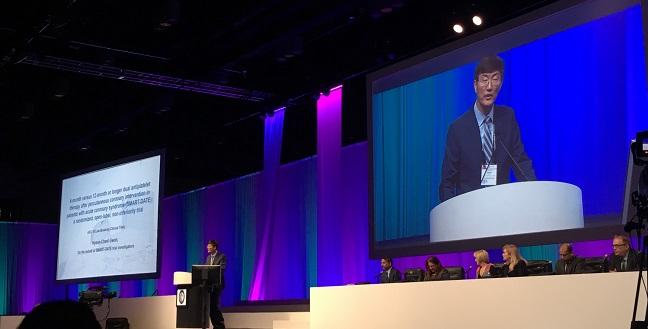Too Soon for 6-Month DAPT, Say SMART-DATE Investigators, Despite Positive Trial
Even though shorter DAPT was noninferior to 12 months in the trial, a signal of higher MI warrants caution and further study, researchers conclude.

ORLANDO, FL—A trial comparing 6 versus 12 months of dual antiplatelet therapy in ACS patients undergoing PCI with current-generation DES saw no difference in its primary composite endpoint, but a signal of more MI among those taking DAPT for 6 months needs to be taken seriously, investigators said here.
“Prolonged DAPT in ACS patients without excessive risk of bleeding should remain the standard of care,” said study presenter Hyeon-Cheol Gwon, MD (Sungkyunkwan University School of Medicine, Seoul, South Korea), during a late-breaking clinical trial session today at the American College of Cardiology 2018 Scientific Session.
For the SMART-DATE study, which was simultaneously published in the Lancet, Joo-Yong Hahn, MD (Sungkyunkwan University School of Medicine, Seoul, South Korea), Gwon, and colleagues randomized 2,712 patients with STEMI, NSTEMI, or unstable angina receiving everolimus-, zotarolimus-, or biolimus-eluting stents at 31 South Korean institutions to treatment with 6 months or more than 12 months of DAPT.
Patients randomized to 6-month DAPT had similar rates of the primary endpoint (MACCE; all-cause mortality, MI, and stroke) at 18 months as those assigned to DAPT for at least 12 months (4.7% vs 4.2%; HR 1.13; 95% CI 0.79-1.62), meeting the definition of noninferiority for short-term DAPT in this population (P = 0.027).
Neither all-cause mortality nor stroke differed between the study arms, but the rate of MI was significantly higher for patients randomized to 6 versus 12 months of DAPT (1.8% vs 0.8%; 95% CI 1.15-5.05). There was a trend toward decreased BARC 2-5 bleeding with shorter DAPT (2.7% vs 3.9%; HR 0.69; 95% CI 0.45-1.05).
Of note, there was some crossover between the study arms, with just 73.7% and 95.7% of patients assigned to short- and long-term DAPT, respectively, adhering to the study protocol. Clopidogrel was the antiplatelet used in 79.7% and 81.8% of patients randomized to 6 and 12 months of DAPT, respectively, given that newer agents were not available in South Korea at the beginning of the study, Gwon explained.
Long-term DAPT Should Be Maintained
“It’s interesting that you met your primary endpoint but you are advising against the change in practice,” commented panel moderator Roxana Mehran, MD (Icahn School of Medicine at Mount Sinai, New York, NY), after Gwon’s presentation. This paper and others “are continuing to tell us that in the non-high-bleeding-risk patients it probably behooves us to continue the 12 months of dual antiplatelet therapies for now, until we have new results.”
In a press conference, Dipti Itchhaporia, MD (Jeffrey M. Carlton Heart and Vascular Institute, Newport Beach, CA), noted that current guidelines recommend DAPT for 12 months or longer in ACS patients because they have a high risk of recurrent ischemic events. “As an interventionalist, we’ve had more of a conversation about bleeding risk—that's the movement toward radial and trying to give shorter therapies so that we can decrease that bleeding risk,” she said. “I think there are a lot of us in the interventional community that have felt that maybe some of the trials that had directed the guidelines were based on older platforms of drug-eluting stents and that maybe with the more current drug-eluting stents that this may change.”
SMART-DATE, however, would support sticking to the guidelines for ACS patients, especially since “there's really not a significant increase in the bleeding risk,” Itchhaporia observed.
Session panelist Gregg W. Stone, MD (Columbia University Medical Center, New York), acknowledged that “these are difficult trials to perform,” but took issue with the fact that patients were randomized at the outset. “There’s a methodologic issue that many of the people who have run these short DAPT trials have fallen into, a trap if you will, and that is [because] the optimal time to randomize is after the period in which you're going to switch the DAPT duration,” he said. “Especially when you’re doing noninferiority/superiority, anything that happens, in your case, before 6 months just adds noise to the trial results because it should be the same in both arms.”
Gwon told TCTMD that randomizing the patients when they did is “both an advantage and a disadvantage.” Specifically, randomizing patients at 6 months would have likely meant a substantial number of patients would have been lost. “Theoretically, it's reasonable to randomize patients when the treatment is changed, but in reality, it's a serious limitation of design,” he said. “Also, during the 6 months, the doctor and patient can change their minds if [the patient is] at high risk of thromboembolic events.”
Both the DAPT Study and DAPT-STEMI trial saw drop-offs of 50% and 25%, respectively, in patients from the beginning of the studies through the time of randomization, he noted.
Regardless, along with data from the REDUCE trial, these findings “support a longer duration of DAPT, not a shorter duration of DAPT, in biomarker-positive ACS in patients who are at reasonable bleeding risk,” Stone said.
Yael L. Maxwell is Senior Medical Journalist for TCTMD and Section Editor of TCTMD's Fellows Forum. She served as the inaugural…
Read Full BioSources
Hahn J-Y, Song YB, Oh J-H, et al. 6-month versus 12-month or longer dual antiplatelet therapy after percutaneous coronary intervention in patients with acute coronary syndrome (SMART-DATE): a randomised, open-label, non-inferiority trial. Lancet. 2018;Epub ahead of print.
Disclosures
- SMART-DATE was supported by Abbott Vascular Korea, Medtronic Vascular Korea, Biosensors Inc, and Dong-A ST.
- Gwon reports receiving consulting fees/honoraria from Medtronic Asia Pacific and research grants from Abbott Korea, Boston Scientific Korea, and Medtronic Korea.
- Hahn reports receiving grants from Abbott Vascular, Boston Scientific, and Biotronik; and speaker’s fees from AstraZeneca, Daiichi Sankyo, and Sanofi-Aventis.


Comments